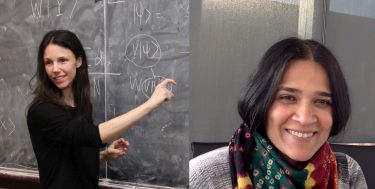
Now, calculations by researchers in the US indicate that defects in silicon carbide (SiC) – which is CMOS-compatible – may have winning attributes to fit these requirements.

Exploiting the quirks of quantum mechanics in real-world technologies – such as quantum communication – requires material systems that enable the transfer and exchange of quantum entanglement between different systems. Now, calculations by researchers in the US indicate that defects in silicon carbide (SiC) – which is CMOS-compatible – may have winning attributes to fit these requirements.
A key aspect of making quantum technology an everyday reality is finding an industry-compatible everyday material system that meets several, highly nuanced quantum-property requirements to fit theoretical protocols for entanglement. No great surprise then that the jury is still out in finding such a material system. However, calculations by Sophia Economou at Virginia Tech and Pratibha Dev at Howard University in the US suggest that silicon carbide may be a contender.
So-called NV centres in diamond – where a carbon atom next to a vacancy defect is substituted with a nitrogen atom – have attracted much interest already because of the demonstrated entanglement between the spin of electrons in the defect and photons. “But it has certain drawbacks because diamond is a hard host, so you cannot turn it into chips easily and so on,” explains Pratibha Dev, who is assistant professor at Howard University and brings her expertise in material sciences to the search for optimal quantum technology materials.
“It turns out that SiC has defects that have similar properties to NV centres in diamond – they provide the same features, but then they have additional properties, for instance even more possibilities for ‘deep defects’.” Deep as opposed to shallow defects refers to states with highly localized wave functions, so that it is easy to manipulate quantum properties like spin. Here, solid-state systems may have the edge over alternatives such as optically trapped atoms. There are also advantages for scaling and combining with devices, as silicon carbide is already being used industrially.

Entanglement systems
What it takes to be a quantum contender
“One feature that is very important is that the material systems have transitions that are favourable for entanglement generation,” explains Economou, who is associate professor in the Department of Physics at Virginia Tech and specializes in the quantum information side of this research. “You start with an excited state – say, electrons are excited – and eventually they spontaneously decay to the ground state. That process can take place by two paths, and the two paths happen quantum mechanically coherently.”
As an example, Economou describes an end state where one decay path leads to the electron spin up and the photon right circularly polarized, and the other decay path ends up with the electron spin down and the photon left circularly polarized. Because both routes are possible, both happen quantum mechanically: the joint electron and photon state end up in a superposition of spin up and right circular polarization and spin down and left circular polarization. The electron is then quantum entangled with the photon.
Economou and Dev started investigating the silicon vacancy defect in silicon carbide, but they also found that silicon double vacancies as well as NV centres were also possible candidates for spin-photon entanglement in silicon carbide. They then investigated different entanglement protocols such as the Λ system – which describes a series of energy transitions that can produce a photon entangled with a spin – and the II system, which can be pumped to extract strings of entangled photons.
“Going from this beautiful mathematical theory that describes the world to how its counterintuitive features can be exploited to make technologies is very interesting for me,” adds Economou.
Levelling with a quantum contender
The researchers determined the possible wavefunctions and eigenvalues of the system with density functional calculations using the Quantum-ESPRESSO package. The only input data in the calculations are the elements and the crystalline structures. “We do not make any assumptions and there are no parameters that you tweak to make them fit,” says Dev.
While single-photon production from silicon carbide has been demonstrated previously, there has been little other work on the material as a potential spin-photon entanglement system for quantum communications. Economou tells nanotechweb.org that they would like to understand interactions with the environment of the defect to help experimentalists realise these systems. They are also interested in not just extracting one-dimensional strings but potentially two-dimensional systems of entangled photons.